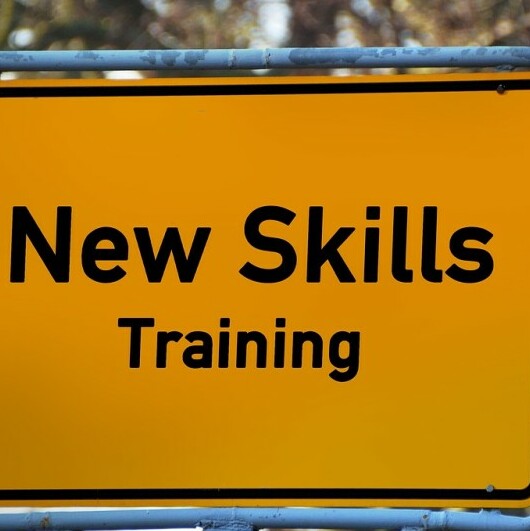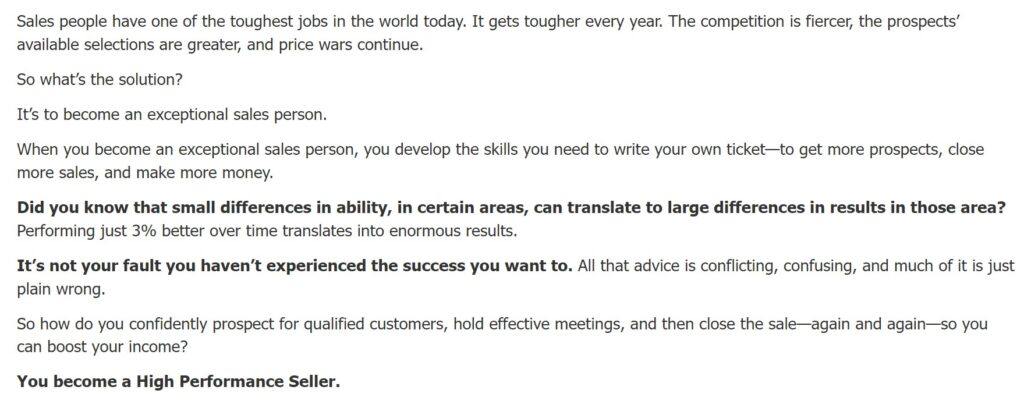
I will start by saying that before you can sell anything, you need to become an expert on your offering. You’ve got to know the product like the back of your hand. This isn’t just about being familiar with what the product does; it’s also about understanding what makes it unique and why it matters to your customers.
How can you highlight features and benefits in a way that resonates? Here’s my advice: think like a customer. Why would you care about this product? How does it make life easier, better, or more enjoyable? You aim to communicate this information so clearly that potential buyers get it instantly.
In my opinion, instilling confidence in your clients is critical. If you’re assured about your product, that certainty is contagious. People are drawn to confidence. It’s not enough to showcase your product; your depth of knowledge and passion for it must come through every time you talk about it.
Selling is Everything!
Before discussing your product audience, let’s talk about basic sales theory.
It does not matter who you are or what you do! You sell every day, and everyone does. You sell who you are to an employer, you sell people your vision of things you want, you sell ideas to your family for things you want to happen, and if you are lucky, you sell a product or service that the world needs.
To be quite honest, nothing gets done until somebody sells something!
Most of today’s billionaires started as salespeople. Selling is what makes the world work and drives the economy. Some people get the wrong idea about selling. They believe it takes unethical and shady tactics to be successful in sales. That is just not true!
Selling is about finding out what someone’s problem is and providing value while solving it. That approach helps people lead more fulfilling lives. Think of it this way: selling is serving!
My favorite mentor over the years has been Zig Ziglar. This is one of my favorite books that he wrote!
Identifying Your Audience: Crafting a Personalized Approach
Right, so after getting to grips with your product, the next step is to zero in on the people who will love what you have to offer. That’s going to be your target audience. And guess what? Your sales will thrive when you fine-tune your approach to meet this group’s specific wants and needs.
Let’s talk about pinpointing who these folks are. It’s not just about demographics like age or location. I’m talking about digging deep to understand their hobbies, challenges, and what gets them excited. This isn’t just about creating a buyer persona; it’s a roadmap to their motivations and buying triggers.
So, how do you tailor your sales pitch? Start simple. Listen to your potential customers, engage with them on social media, and gather feedback whenever possible. Trust me, people love to share their opinions. Use this golden info to adapt your message to hit just the right note.

Additionally, doing your homework with solid market research can shed light on untapped opportunities or rising trends that resonate with your audience. It’s like connecting the dots between what your audience craves and the exceptional ways your product can meet those desires.
Once you truly understand who you’re selling to, every piece of your sales strategy becomes more intuitive and effective. It’ll be crystal clear how to tweak your messaging, align your marketing, and ultimately, sell without feeling like you’re selling. And believe me, that’s where the real magic happens.
Creating a Compelling Value Proposition
I will agree with you that the value proposition is your secret weapon. This isn’t just about listing features; it’s about sharing why your product is a game-changer for the customer. Ponder for a moment: What makes your product stand out? Why should anyone choose yours over the countless options available?
Here’s how you can distill this: Start by putting yourself in your customers’ shoes. What’s in it for them? Perhaps it’s the time they’ll save, the money they’ll keep in their pockets, or the sheer joy of using a product that works flawlessly. Your job is to pinpoint these perks and make them the stars of your sales pitch.
Now, you might think that jargon and complex language will impress your audience, but trust me, simplicity reigns supreme. Outline the benefits with crystal clarity. Let’s say you’re selling a revolutionary kitchen gadget; don’t just say it’s ‘innovative’ – explain that it cuts cooking time in half. See the difference?

Remember, a stellar value proposition does more than inform; it connects emotionally. Share stories of how your product has improved lives or solved problems. These narratives often stick in a buyer’s mind long after reading the product description.
A robust value proposition can also bridge the gap to your following sales technique – mastering the online presentation. When a customer is intrigued by your product’s promise, they will want to see it. That’s where the magic of high-quality images and detailed descriptions takes center stage, but we’ll dive deeper into that in the next section.
The Virtual Showcase: Mastering Online Presentation
You’ll learn about the importance of the visual aspect when selling online. You must bridge that gap since potential customers can’t physically handle the products. High-quality images not only serve this purpose but also establish a level of professionalism and attention to detail that reflects on your brand.
When presenting products online, each detail in your visuals counts. Well-lit, high-resolution photos from multiple angles give customers a better idea of what they’re buying. If applicable, include images of people using the product to add context and scale. Remember, the goal is to replicate the in-store experience as closely as possible.
But it’s not just about the pictures; your chosen words are equally vital. Descriptive product listings that highlight key features, dimensions, and usage instructions overcome the sensory limitations of online shopping. Use language that speaks to your audience’s pain points and showcases how your product solves them.

Your product descriptions should tell a story. It is not a long-winded tale but a precise narrative that connects emotionally, highlighting how the product can enhance the customer’s life. This isn’t just about what the product is; it’s about what it does for the customer.
A common mistake is to focus too much on technical jargon that can be off-putting or confusing. Instead, strike a balance where technical terms are used where necessary but explained in a way that’s accessible to those not familiar with the lingo. Empathy is vital; put yourself in the shoes of someone who knows nothing about the product and write from there.
Fostering Trust: Excelling in Customer Service
I’m here to help you master the art of customer service, which can be as crucial as the quality of your product. When it comes to online sales, you don’t meet customers face-to-face, so providing top-notch customer service through other channels becomes even more critical. It’s not just about answering questions; it’s about creating a positive impression that builds trust and loyalty.
Being responsive and courteous with your customer’s inquiries or concerns can go a long way, and here’s why. First, it shows that you value your customers and their experience. This means getting back to them quickly, providing clear answers, and showing empathy when things are unplanned. A customer who feels heard and supported is likelier to become a repeat customer.
But good customer service isn’t just reactive; it’s proactive. You can constantly adjust your approach, but setting up a customer service system that anticipates and addresses concerns before they arise will set you apart. This could be through comprehensive FAQs, helpful tutorials, or even a chatbot that can answer basic questions 24/7.

Now, implementing feedback loops is critical for continuous improvement. Encourage customers to share their experiences and act on their suggestions. Learn from every interaction to make your service stand out. This isn’t just a nice-to-have; it’s essential for keeping yourself ahead of the competition.
I hope you see the link between excellent customer service and increased sales. When people trust your brand, they’re not only more likely to buy; they’re also more likely to recommend it to others. It’s a powerful cycle that starts with a simple ‘Hello, how can I help you today?’
Incentivizing Purchases: The Art of Promotions and Discounts
I will tell you a little secret: everyone loves a good deal. Promotions and discounts aren’t just bait; they’re tried-and-true methods to nudge potential buyers into purchasing. When someone feels like they’re getting more value for their money, they’re more likely to pull out their wallet.
You can constantly adjust your approach down the road, but to start with, tailor offers that align with your product’s image and your audience’s expectations. Choose something that resonates with your business objectives and your customers’ desires. For instance, a limited-time offer creates urgency, while a buy-one-get-one deal can increase the perceived value.
Now, this strategy is powerful, but I would also urge caution. When setting up promotions, you must be mindful of your profit margins. A great deal won’t help if you’re not making enough to sustain your business. Set clear promotion terms and conditions to balance attracting customers and remaining profitable. Promotions are critical to your growth as a salesperson when you’re starting.

Don’t forget about repeat business, either. A well-timed discount to a returning customer can turn a one-time buyer into a loyal fan. It’s like saying, ‘Hey, I remember you and value your business.’ This personal touch goes a long way toward building lasting customer relationships.
Remember, promotions and discounts are not set-and-forget tactics. You should monitor their performance, measure the uptake, and tweak as needed. You aim for an incentive strategy that benefits you and your customers, creating a win-win scenario. That’s the strategy I like to leverage, and I hope you see success with it, too.
Embracing Adaptability: The Cycle of Sales Improvement
I will wrap up by reiterating the importance of adaptability in the sales world. Thinking on your feet and being willing to shift strategies are critical to your growth as a salesperson when launching a sales career.
You’ve probably noticed that online sales move more quickly than traditional sales. Your ability to adapt based on customer feedback and sales performance data isn’t just recommended; it’s essential.
Don’t worry too much about perfecting it right out of the gate. Your first attempt doesn’t need to be your last. Use every sale, every interaction, and every feedback as a learning opportunity.
Track what’s working and, more importantly, what isn’t. This includes keeping an eye on your website’s analytics, the response rates to follow-up emails, and the reception of your customer service.

In my opinion, continuous improvement is the most exciting part of sales. You can constantly adjust your approach, testing new techniques and honing the ones that show promise.
Choose something that resonates with you from each strategy we’ve discussed, and try it. Remember, the sales field is one where experience is the best teacher.
I hope you’ve found this guide helpful and that you’ll bring these insights into your journey as a sales beginner. Trust in your ability to learn and improve, and success will follow. Best of luck!
You can learn more about me here!
Please feel free to leave a comment or question below. I would love to assist you in any way I can!



